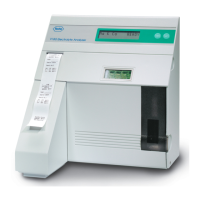Roche Diagnostics
108 Instructions for Use · Version 10.0
7 Measurement 9180 Electrolyte Analyzer
Measuring procedure
Measuring procedure
WARNING
Inappropriate collecting and handling of samples of human origin may result in
infection
Inappropriate collecting and/or handling samples of human origin may lead to the
transmission of blood or urine borne pathogens.
r Follow standard laboratory practices.
r Wear appropriate personal protective equipment.
r If a sample of human origin is spilled, wipe it up immediately and apply a disinfectant.
r If a sample of human origin comes into contact with your skin, wash the affected area
immediately with soap and water an apply a disinfectant. Consult a physician.
WARNING
Failure to follow QC protocols or ignoring QC results may lead to incorrect patient
results
Failure to follow QC protocols or ignoring QC results may lead to incorrect patient results,
which may endanger patient lives.
r Follow quality control practices according to local regulations.
r Perform a minimum of one QC measurement each day. In addition, alternate through
the 3 levels of available QC materials over the course of 3 days. For example, perform a
QC measurement on day 1 with a level 1 QC material, on day 2 with a level 2 QC
material and on day 3 with a level 3 QC material.
r Perform QC tests on 3 levels after each of these actions: electrode replacement,
SnapPak replacement, start-up of the analyzer, pump tubing set replacement, main
tubing harness replacement, sample probe and fill port replacement, and cleaning of
the reference electrode housing
r If QC results do not match their expected results, perform the QC measurements again.
If QC results still do not to match their expected results, contact Roche Technical
Support.
r Do not use the analyzer for diagnostic purposes until QC results match their expected
results.
Sample measurement
The 9180 Electrolyte Analyzer provides fast and easy operation. Whenever READY
appears, the analyzer is ready to perform sample measurements.
WARNING
Incorrect patient results due to mismatch between sample type and analyzer
mode
If the analyzer mode does not match your measured sample type, incorrect patient results
may be generated. This may lead to errors in diagnosis, posing danger to the patient.
r After each measurement, confirm that the analyzer mode on your measurement report
matches your sample type.
CAUTION
Loss of sample due to insufficient sample volume
If your sample volume is less than 100 μL, you may not obtain a measurement for your
sample and it will be lost.
r Ensure that you use sample collection containers with a maximum volume greater than
100 μL.

